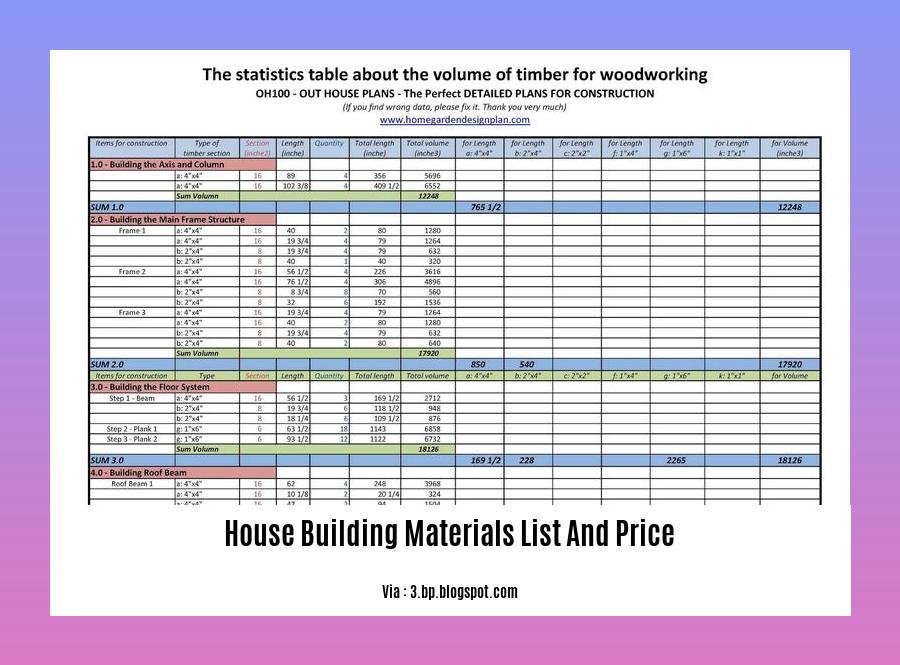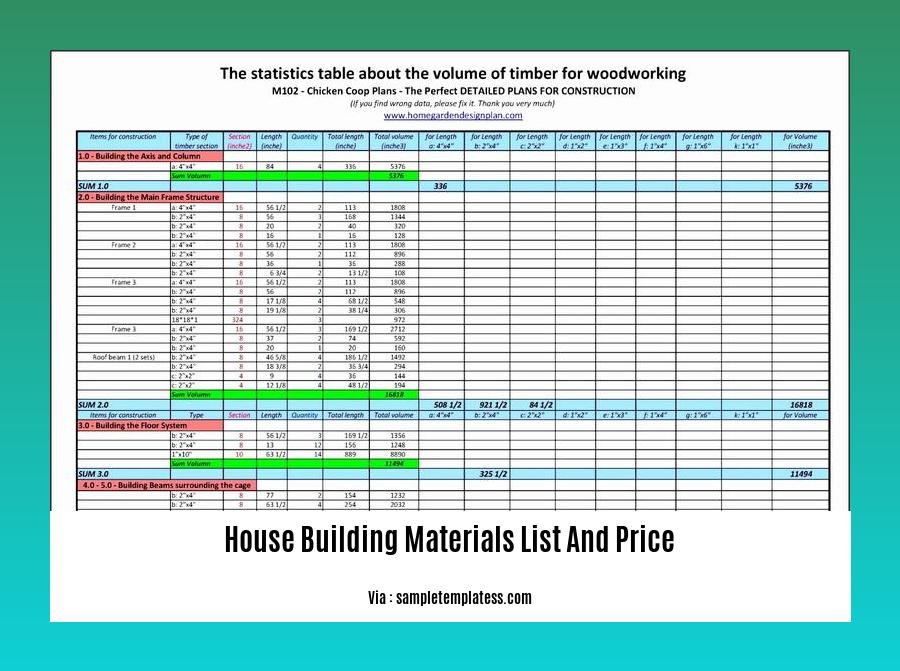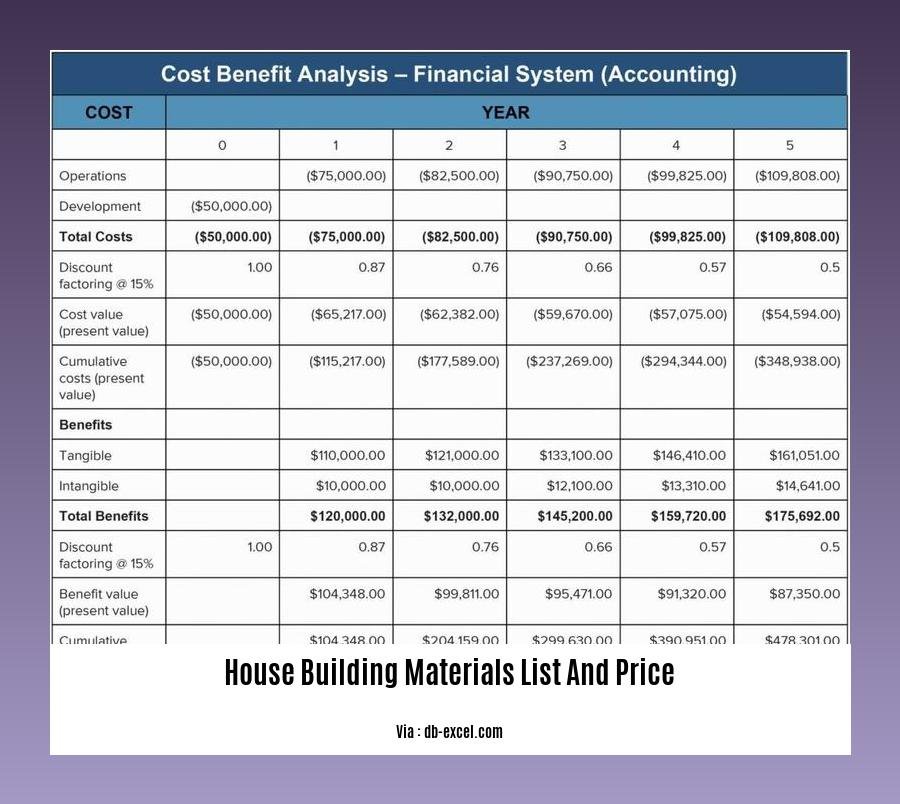Welcome to [A Comprehensive House Building Materials List and Price Guide], your ultimate resource for understanding the materials and pricing involved in residential construction. Whether you’re a seasoned builder or a first-time homeowner, this guide will provide you with the insights you need to make informed decisions about your building project.
Key Takeaways:
- Cement: Binds materials in concrete.
- Steel Bars: Reinforce concrete for strength.
- Sand: Used in concrete and mortar.
- Concrete: Pre-mixed for convenience.
- Binding Wires: Bind steel reinforcement.
- Rocks/Stones: Form concrete and asphalt.
- Bricks/Blocks: Create walls and partitions.
- Hoop Iron: Supports masonry and concrete.
- Timber: Used for framing and finishing.
House Building Materials List and Price

Every home builder’s voyage begins with choosing the right materials. It’s like planning a journey; the materials you pick now will shape your home’s future. To help you navigate this crucial decision, here’s a comprehensive list and pricing guide for house building materials:
Structural Materials:
- Frames: The backbone of your house, frames (usually wooden or steel) create skeletal support for walls and roofs.
- Walls: Protect you from elements; brick, concrete, or timber frame walls offer strength and insulation.
- Beams: Think of these as the pillars of your roof, supporting its weight and keeping it steady.
- Slabs: If your home has a flat roof, slabs are its foundation. These concrete layers create a sturdy base for roofing.
- Columns: Like mighty oaks, columns support beams, transferring loads and ensuring stability.
Exterior Materials:
- Roofing: Shields your home from rain, wind, and sun. Choose from asphalt shingles, metal, or tiles.
- Siding: The protective layer that covers your walls. Vinyl, wood, or stucco give a house its unique character.
- Windows: Let light in and provide ventilation. Double-paned windows can improve insulation.
- Doors: Entry points and exits. Doors come in a variety of styles, from classic wood to modern glass panels.
Interior Materials:
- Flooring: The surface you walk on! Choose from tiles, wood, laminate, or carpet, considering durability and style.
- Drywall: The smooth, paintable surface on your walls. It’s made of gypsum panels or plaster.
- Paint: The canvas for your home’s interior design. Choose from countless colors and finishes.
- Fixtures: Lighting, faucets, and appliances. They add functionality and style to your home.
Pricing Guide:
Material costs vary depending on factors like size, quality, and location. Here are approximate price ranges to help you plan:
| Material Type | Approximate Cost Range |
|---|---|
| Cement | $100-$150 per ton |
| TMT/TMX Steel | $1,500-$2,000 per ton |
| Sand/Fine Aggregates | $20-$30 per cubic foot |
| Ready Mix Concrete | $100-$150 per cubic yard |
| TMT Binding Wires | $50-$75 per bundle |
| Coarse Aggregates | $20-$30 per cubic foot |
| Bricks/Blocks | $0.50-$1 per block |
| Hoop Iron | $30-$40 per 100 feet |
| Machine Cut Timber | $50-$100 per cubic foot |
Remember, these prices serve as a guide. Consult with local suppliers for accurate estimates.
Choosing Materials:
Selecting materials wisely is key to building a durable, beautiful home. Consider these tips:
- Assess Project Needs: Choose materials that meet your home’s specific requirements, considering factors like weather, terrain, and lifestyle.
- Durability: Opt for materials that stand the test of time, reducing long-term maintenance costs.
- Sustainability: Explore eco-friendly alternatives like recycled materials or energy-efficient products.
- Codes: Always adhere to building codes and local regulations to ensure safety and quality.
Selecting the right materials is a journey, not a race. Take your time, research options, and consult with professionals to make informed decisions that will shape the home of your dreams.
For an accurate estimate of the cost of building your dream home, utilize our comprehensive house building cost calculator.
If you’re embarking on the journey of constructing your own abode, refer to our detailed house construction checklist to ensure a smooth and organized process.
Explore our directory of reputable house construction companies to find the ideal partner for your building project.
For those seeking construction services within the vibrant city of Bangalore, our curated list of house construction companies in Bangalore offers a comprehensive overview of the available options.
Tips for Choosing Materials: Needs, Durability, Sustainability

Choosing the perfect materials for your house is just like picking the perfect ingredients for your favorite dish. You want to consider your specific needs, how long they’ll last, and how they impact the environment.
Materials for a Solid Foundation
First off, let’s talk about the bones of your house. The frame is like the skeleton, providing structural support. Walls, made of materials like brick or concrete, keep you sheltered and insulated. Beams and slabs distribute weight, ensuring a sturdy roof and a strong foundation.
Materials for a Beautiful Facade
Now, let’s dress up your house’s exterior! Roofing protects from the elements, siding adds character, windows bring in light, and doors welcome you home. Choose materials that match your style and withstand the test of time.
Materials for a Comfortable Interior
The inside of your house is where you’ll spend most of your time, so make it cozy! Flooring provides support and style, drywall gives walls a smooth finish, paint adds color and personality, and fixtures like lighting, appliances, and faucets enhance functionality and aesthetics.
Materials for a Sustainable Future
Don’t forget to consider the environment when choosing your materials. Sustainable options like bamboo, recycled metal, and reclaimed wood help reduce your carbon footprint. They’re renewable, energy-efficient, and durable, so you can feel good about your choices.
Key Takeaways:
- Choose materials that align with your specific needs.
- Prioritize durability to minimize maintenance costs in the long run.
- Embrace sustainability for a greener, healthier home.
- Consult with professionals to make informed decisions.
[Citation:
Structural Materials: Frames, Walls, Beams, Slabs, Columns
Key Takeaways:
- Frames: Usually made of wood or steel, they provide the skeletal support for your house.
- Walls: They serve as protective barriers and insulation. Common materials include brick, concrete, and timber.
- Beams: These support the weight of the roof.
- Slabs: These form the foundation of flat roofs.
- Columns: They transfer loads and ensure structural stability.
Materials for Structural Components:
- Reinforced Concrete: A mix of concrete and steel rods, it’s strong and durable yet cost-effective, making it a popular choice in many construction projects.
- Steel: Known for its exceptional strength and versatility, steel is often used in commercial and industrial buildings due to its ability to create large, open spaces.
- Wood: A traditional and sustainable option, wood is commonly used in residential construction for its warmth and affordability.
Pricing:
Pricing for structural materials can vary depending on factors like the size of your project, the quality of materials used, and the local availability. For example, steel beams tend to be more expensive than wood beams, but they may be necessary for larger structures or those requiring greater strength.
Choosing Materials:
Consider aspects such as the specific needs of your project, its location, and the desired durability. Factors like energy efficiency, sustainability, and local building codes should also be taken into account.
Citation:
- Components of a Structure in Architecture
Exterior Materials: Roofing, Siding, Windows, Doors
Key Takeaways:
- Roofing: Choose durable materials like asphalt shingles, metal, or tiles to protect against harsh weather conditions.
- Siding: Opt for low-maintenance options like vinyl, wood, or stucco to enhance the appearance and durability of your home’s exterior.
- Windows: Consider energy-efficient windows with double- or triple-pane glass and low-emissivity coatings to improve insulation and reduce energy costs.
- Doors: Select sturdy and secure doors made from wood, fiberglass, or steel to provide both functionality and curb appeal.
Deciding on the ideal exterior materials for your home can be a daunting task, but by considering factors such as durability, maintenance, and aesthetic appeal, you can make informed choices that will enhance your home’s beauty and functionality for years to come.
When it comes to roofing, the material you choose will play a crucial role in protecting your home from the elements. Asphalt shingles are a common and affordable option, offering a wide range of colors and styles. Metal roofing is highly durable and energy-efficient, but it can be more expensive than asphalt shingles. Tiles, such as clay or ceramic, provide a classic and elegant look but require more maintenance than other roofing materials.
For siding, vinyl is a popular choice due to its low maintenance and affordability. It’s available in various colors and styles to match any home’s aesthetic. Wood siding offers a timeless and natural look but requires regular maintenance, including painting or staining. Stucco provides excellent durability and weather resistance, but it can be more expensive than other siding options.
Energy-efficient windows can make a significant impact on your home’s comfort and energy bills. Double- or triple-pane glass with low-emissivity coatings helps reduce heat loss in the winter and heat gain in the summer. Consider the size, shape, and style of windows that complement your home’s architectural design.
When selecting doors, security and durability should be your top priorities. Wood doors offer a classic and elegant look but require regular maintenance. Fiberglass doors are strong and energy-efficient, and they can be made to resemble wood without the same maintenance needs. Steel doors are the most durable and secure, but they can be more expensive than other door materials.
By carefully considering the various Exterior Materials: Roofing, Siding, Windows, Doors, you can choose the perfect combination to enhance your home’s style, protect it from the elements, and create a comfortable living space that meets your unique needs and preferences.
Citation: Exterior Home Building Materials: What To Know
FAQ
Q1: What are the most essential structural components of a house?
A1: Slabs, beams, columns, and footings are the fundamental structural components that provide support and stability to a house.
Q2: What factors determine the price of building materials?
A2: Prices for building materials fluctuate based on factors such as availability, demand, transportation costs, and labor costs.
Q3: What is the difference between ready mix concrete and site-mixed concrete?
A3: Ready mix concrete is pre-mixed and delivered to the construction site, while site-mixed concrete is mixed on-site using ingredients like cement, sand, and aggregates.
Q4: What are the benefits of using sustainable building materials?
A4: Sustainable building materials offer environmental benefits such as a lower carbon footprint, improved air quality, and reduced waste compared to traditional materials.
Q5: How can I find current and accurate pricing for building materials?
A5: Reliable sources for up-to-date building material pricing include construction material suppliers, contractor estimates, and online pricing platforms.
- Annapolis Mall Map & Directory: Find Stores, Restaurants & More - March 29, 2025
- Angel of Harmony Statue Vandalized at St. Louis Cathedral Basilica - March 29, 2025
- Amur River Maple ( Acer ginnala): A Comprehensive Guide (Including Invasiveness) - March 29, 2025










